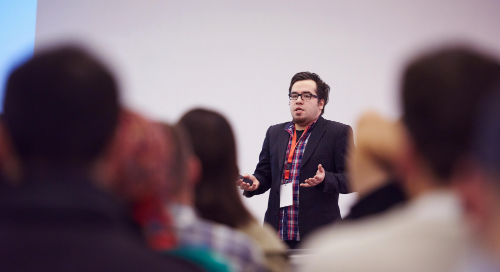a-second-look-at-our-interview-with-john-graham-ceo-of-the-worlds-largest-society-for-association-executives-asae
August 08, 2014
Source: John Graham
Tomorrow marks the first day of the ASAE meeting in Nashville, TN, so what better reason to dig into the archives and take a second look at our interview with ASAE CEO John Graham. If you’re heading to Nashville, don’t forget to stop by Wiley’s booth (#300) to say hello and be sure to attend the sessions “Create your digital strategy” (Sunday) and “5 Key Trends in Professional Publishing” (Tuesday), featuring Wiley speakers. If you can’t make it in person, we’ll be bringing you highlights next week here on Exchanges and follow us @WileySocieties for the latest.
Q. Thank you for talking to us John. Please can you start by telling us about ASAE – The Center for Association Leadership, and your role there?
A. I have been President and CEO of ASAE for 10 years, and I am responsible to the Board of Directors for the management and leadership of the organization. ASAE has around 22,000 members, primarily leading trade and professional associations, as well as some of the larger philanthropic organizations. We have four core competencies: 1) creating, curating, and distributing a body of knowledge around association management and leadership; 2) providing learning opportunities, both physical and virtual (online and streamed versions of live meetings), which includes hundreds of programs annually on association management, and about 20% are on personal skills development such as leadership, management, etc; 3) creating a community, physical and virtual, that enables people to come together to learn and share; 4) advocacy – by celebrating the value and contribution of associations to society. Just about everything you do every day – crossing a bridge, driving a car, going to a doctor – relies on a body of knowledge that has been provided by an association, which has set standards, written guidelines, provided training, etc. We also address issues that impact tax exempt organizations including tax policy, tax exemptions, and First Amendment rights.
Q. ASAE is in a unique position as a membership organization whose members are themselves membership organizations – how does that affect what you do?
A. We are the association for associations – for those individuals who are working as staff in these organizations. We are their professional home, and this is what we’ve created our body of knowledge around. Our members expect ASAE to help them do their job better as well as more efficiently in order to become better professionals.
Q. What are the main changes you’ve seen in association management over the past 5-10 years?
A. One change is the continual evolution of association management as a career and profession. Members and boards alike now expect their staff to provide high-level expertise and execution. Technology – including social media, digital, and mobile technology – is a game changer for associations. In the same way personal computing revolutionized the 1980s, mobile is revolutionizing society today. It’s allowing members to customize their relationship with their association rather than the association simply delivering a suite of services to them. The next significant game-changer in the US will be changing demographics, especially the rise in the Hispanic population. It’s set to increase from one in seven to one in three over the next 30-40 years. Associations will be impacted by how this new demographic views membership, volunteering, etc.
Q. What are the biggest challenges that your members and their associations are facing today?
A. The biggest challenge is both caused and solved by technology – the issue of engagement. Most of what associations offer is now available free of charge. So, associations need to create packages that allow people to get that information quicker, cheaper, and more efficiently. This is their value proposition, and it requires membership models to evolve. Rather than everyone paying roughly the same dues for the same services, we are now moving to more of a cafeteria service that allows people to pick and choose what they want. The organizations that don’t move in this direction will become less relevant to young people.
Q. What do you see as the key opportunities?
A. As noted, technology has created an “everything is free” situation for associations, which no longer control access to information. Now, it’s all about how you package that information to make it more valuable to the individual member – that’s where the opportunities lie.
Q. What are some of the main ways that ASAE supports its members in addressing these challenges and opportunities?
A. We do so through our core competencies. We create a body of knowledge to help them understand the issues and how they can organize themselves to best address them. Our learning programs help ensure that associations don’t have to recreate the wheel, and it provides best practices for them to follow in order to make sure they’re on the cutting edge of what they do. Also, and somewhat uniquely, ASAE is an organization that takes risks – we are trying things first, so our members can learn from us about what works and what doesn’t.
Q. Can you tell us a bit about your future plans for ASAE?
A. We are developing a global strategy that embraces digital technology, which can be incorporated into the face-to-face experience. I firmly believe that face-to-face meetings will continue to be vibrant and attractive to members because humans want that personal connection. Digital technology, social networks, and mobile are additive to the face-to-face experience, but we are still learning what that future landscape will look like. We are also interested in how associations manage their content and knowledge. For example, through taxonomies, associations are looking at new ways of slicing and dicing their body of knowledge, so they can make it intuitive for members. These knowledge ecosystems are critical, especially for scientific and professional societies.
Q. Although many of your members are trade and professional associations, you also work with some that are more scholarly and scientific, which are more representative of our readership. Do you see any differences between these two broad types of organizations or do you think the same principles apply to all membership organizations?
A. I don’t think there is a big difference between professional and scientific associations, but there is a difference between professional societies and associations and trade associations. Trade associations are primarily advocacy organizations, even if they also provide some training and content. On the other hand, Professional and scientific associations are nearly identical. Their members are either those who engage in creating science or in establishing what it means to be a professional in the field. Philanthropic societies are different again because they are cause-related organizations not always affiliated with a particular discipline.
Q. Attracting new members is a challenge for most societies – any words of advice on this?
A. The membership model is evolving, so ASAE has created packages where people get a certain number of products and services for a membership at a price point. The value proposition for all associations is around how they package their content. If you do this well, then they’ll engage with you and join (or, if not, they will buy your products anyway). For example, Starbucks customers are willing to pay a higher price for coffee because they perceive it to be of value. Associations have the exact same opportunity.
Q. How optimistic (or not!) are you about the future of societies and other membership organizations and why?
A. I’m very optimistic because people still want to come together for a common purpose – whether that is to solve problems, to learn, or to engage with each other. But, associations will only thrive if they have a good value proposition. If not, they will disappear and be replaced by another (existing or new). You could say that I’m very bullish on associations going forward.







